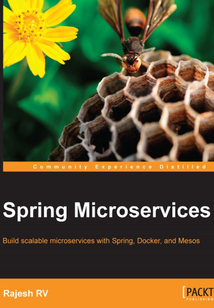舉報(bào) 

會(huì)員
Spring Microservices
最新章節(jié):
Index
IfyouareaSpringdevelopersandwanttobuildcloud-ready,internet-scaleapplicationstomeetmodernbusinessdemands,thenthisbookisforyouDeveloperswillunderstandhowtobuildsimpleRestfulservicesandorganicallygrowthemtotrulyenterprisegrademicroservicesecosystems.
目錄(128章)
倒序
- coverpage
- Spring Microservices
- Credits
- About the Author
- Acknowledgments
- About the Reviewer
- www.PacktPub.com
- eBooks discount offers and more
- Preface
- What this book covers
- What you need for this book
- Who this book is for
- Conventions
- Reader feedback
- Customer support
- Chapter 1. Demystifying Microservices
- The evolution of microservices
- What are microservices?
- Microservices – the honeycomb analogy
- Principles of microservices
- Characteristics of microservices
- Microservices examples
- Microservices benefits
- Relationship with other architecture styles
- Microservice use cases
- Summary
- Chapter 2. Building Microservices with Spring Boot
- Setting up a development environment
- Developing a RESTful service – the legacy approach
- Moving from traditional web applications to microservices
- Using Spring Boot to build RESTful microservices
- Getting started with Spring Boot
- Developing the Spring Boot microservice using the CLI
- Developing the Spring Boot Java microservice using STS
- Developing the Spring Boot microservice using Spring Initializr – the HATEOAS example
- What's next?
- The Spring Boot configuration
- Changing the default embedded web server
- Implementing Spring Boot security
- Enabling cross-origin access for microservices
- Implementing Spring Boot messaging
- Developing a comprehensive microservice example
- Spring Boot actuators
- Configuring application information
- Adding a custom health module
- Documenting microservices
- Summary
- Chapter 3. Applying Microservices Concepts
- Patterns and common design decisions
- Microservices challenges
- The microservices capability model
- Summary
- Chapter 4. Microservices Evolution – A Case Study
- Reviewing the microservices capability model
- Understanding the PSS application
- Death of the monolith
- Microservices to the rescue
- The business case
- Plan the evolution
- Migrate modules only if required
- Target architecture
- Target implementation view
- Summary
- Chapter 5. Scaling Microservices with Spring Cloud
- Reviewing microservices capabilities
- Reviewing BrownField's PSS implementation
- What is Spring Cloud?
- Setting up the environment for BrownField PSS
- Spring Cloud Config
- Feign as a declarative REST client
- Ribbon for load balancing
- Eureka for registration and discovery
- Zuul proxy as the API gateway
- Streams for reactive microservices
- Summarizing the BrownField PSS architecture
- Summary
- Chapter 6. Autoscaling Microservices
- Reviewing the microservice capability model
- Scaling microservices with Spring Cloud
- Understanding the concept of autoscaling
- Autoscaling approaches
- Autoscaling BrownField PSS microservices
- Summary
- Chapter 7. Logging and Monitoring Microservices
- Reviewing the microservice capability model
- Understanding log management challenges
- A centralized logging solution
- The selection of logging solutions
- Monitoring microservices
- Data analysis using data lakes
- Summary
- Chapter 8. Containerizing Microservices with Docker
- Reviewing the microservice capability model
- Understanding the gaps in BrownField PSS microservices
- What are containers?
- The difference between VMs and containers
- The benefits of containers
- Microservices and containers
- Introduction to Docker
- Deploying microservices in Docker
- Running RabbitMQ on Docker
- Using the Docker registry
- Microservices on the cloud
- Running BrownField services on EC2
- Updating the life cycle manager
- The future of containerization – unikernels and hardened security
- Summary
- Chapter 9. Managing Dockerized Microservices with Mesos and Marathon
- Reviewing the microservice capability model
- The missing pieces
- Why cluster management is important
- What does cluster management do?
- Relationship with microservices
- Relationship with virtualization
- Cluster management solutions
- Cluster management with Mesos and Marathon
- Implementing Mesos and Marathon for BrownField microservices
- A place for the life cycle manager
- The technology metamodel
- Summary
- Chapter 10. The Microservices Development Life Cycle
- Reviewing the microservice capability model
- The new mantra of lean IT – DevOps
- Meeting the trio – microservices DevOps and cloud
- Practice points for microservices development
- Microservices development governance reference architectures and libraries
- Summary
- Index 更新時(shí)間:2021-07-02 16:28:55
推薦閱讀
- PHP基礎(chǔ)案例教程
- Cross-platform Desktop Application Development:Electron,Node,NW.js,and React
- OpenStack Cloud Computing Cookbook(Fourth Edition)
- 基于差分進(jìn)化的優(yōu)化方法及應(yīng)用
- PhoneGap Mobile Application Development Cookbook
- FLL+WRO樂高機(jī)器人競(jìng)賽教程:機(jī)械、巡線與PID
- Building Serverless Applications with Python
- Java系統(tǒng)化項(xiàng)目開發(fā)教程
- Essential C++(中文版)
- Android群英傳
- C++編程兵書
- Spring 5 Design Patterns
- Python Automation Cookbook
- DevOps 精要:業(yè)務(wù)視角
- Building Apple Watch Projects
- Building Microservices with Go
- Java EE應(yīng)用開發(fā)及實(shí)訓(xùn)
- 計(jì)算機(jī)教學(xué)研究與實(shí)踐:2017學(xué)術(shù)年會(huì)論文集
- 零基礎(chǔ)學(xué)西門子PLC編程:入門、提高、應(yīng)用、實(shí)例
- Mastering PyCharm
- 我跟爸爸學(xué)編程:從Python到C++
- Spring Batch Essentials
- Go語言學(xué)習(xí)指南:慣例模式與編程實(shí)踐
- Flutter基礎(chǔ)與實(shí)戰(zhàn):從入門到APP跨平臺(tái)開發(fā)
- OpenJDK Cookbook
- CimatronE 10.0三維設(shè)計(jì)與數(shù)控編程基本功特訓(xùn)
- Instant IntroJs
- Android開發(fā)藝術(shù)探索
- MySQL數(shù)據(jù)庫原理及應(yīng)用(第2版)(微課版)
- shell腳本基礎(chǔ)教程

